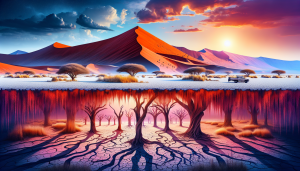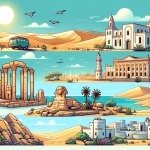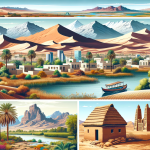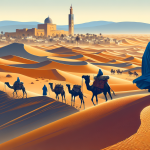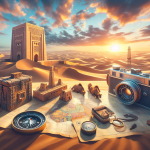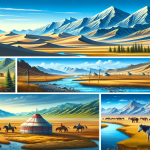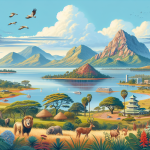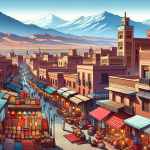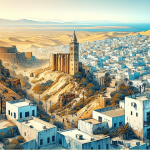Discovering the Untamed Beauty of Namibia
Namibia, a gem nestled in the southwestern corner of Africa, is a land where vast deserts meet the Atlantic Ocean, and where ancient cultures blend seamlessly with modernity. This country, known for its stark landscapes and rich wildlife, offers a myriad of experiences for the intrepid traveler. From the towering sand dunes of Sossusvlei to the rugged terrain of Damaraland, Namibia promises a journey like no other. In this guide, we will explore the various facets of this extraordinary destination, uncovering its hidden treasures and offering tips on how to make the most of your Namibian adventure. Whether you’re drawn to the thrill of a safari in Etosha National Park, the serenity of the Skeleton Coast, or the cultural richness of the Himba people, Namibia has something for everyone. Get ready to embark on a journey through one of the most captivating and diverse countries on the African continent.
The Diverse Landscapes of Namibia
The Namib Desert: A Sea of Endless Dunes
The Namib Desert, one of the oldest deserts in the world, is a must-visit for any traveler to Namibia. Spanning over 1,200 miles along the Atlantic coast, this desert is home to some of the highest sand dunes on the planet. The most iconic of these is Sossusvlei, where the red-orange sand dunes create a surreal and photogenic landscape. Visitors can climb Dune 45 or the even taller Big Daddy for panoramic views that are nothing short of breathtaking. The stark beauty of Deadvlei, with its white clay pan and skeletal trees, adds another layer to the desert’s allure.
Etosha National Park: A Wildlife Enthusiast’s Paradise
Etosha National Park is one of Africa’s premier wildlife destinations. Covering an area of over 8,600 square miles, the park is home to a diverse array of animals, including elephants, lions, rhinos, and a variety of antelope species. The Etosha Pan, a vast salt flat, is the park’s centerpiece and acts as a magnet for wildlife, especially during the dry season. Waterholes scattered throughout the park provide excellent game viewing opportunities. Visitors can embark on self-drive safaris or guided tours to explore this wildlife haven.
The Skeleton Coast: Where Desert Meets Ocean
The Skeleton Coast, named for the countless shipwrecks that have occurred along its treacherous shores, is one of Namibia’s most enigmatic regions. This remote and desolate coastline stretches from the northern town of Swakopmund up to the Angolan border. The Skeleton Coast National Park offers a unique blend of desert and coastal ecosystems, where the Atlantic Ocean’s misty fogs nourish life in an otherwise arid environment. Visitors can explore shipwrecks, encounter colonies of Cape fur seals, and marvel at the otherworldly landscapes that define this hauntingly beautiful area.
Cultural Richness and Heritage
The Himba People: Guardians of Tradition
Namibia is not only known for its natural beauty but also for its rich cultural heritage. The Himba people, one of the country’s most iconic ethnic groups, have preserved their traditional way of life for centuries. Living primarily in the remote regions of Kaokoland, the Himba are known for their distinctive red ochre body paint and elaborate hairstyles. Visiting a Himba village offers a unique opportunity to learn about their customs, daily life, and the challenges they face in a rapidly changing world. It’s a cultural experience that provides insight into the resilience and adaptability of this remarkable community.
The San People: The Original Inhabitants
The San people, also known as Bushmen, are considered the original inhabitants of Southern Africa. Their history in Namibia dates back thousands of years, and they are renowned for their deep understanding of the natural world. The San’s traditional knowledge of plants, animals, and survival skills is unparalleled. Visitors can join a San-guided tour to learn about tracking wildlife, gathering edible plants, and the San’s unique click-language. This immersive experience offers a glimpse into the lifestyle and wisdom of one of the world’s oldest cultures.
Adventure Activities in Namibia
Sandboarding and Dune Activities
For those seeking adrenaline-pumping activities, Namibia’s vast sand dunes provide the perfect playground. Sandboarding down the towering dunes of Swakopmund is an exhilarating experience that attracts thrill-seekers from around the globe. Whether you’re a beginner or an experienced boarder, the dunes offer various slopes to suit all skill levels. Additionally, quad biking through the desert landscapes provides another thrilling way to explore the sandy expanses.
Hot Air Ballooning Over the Namib Desert
One of the most magical ways to experience the Namib Desert is from above. Hot air ballooning offers a unique perspective of the desert’s vastness and beauty. As the sun rises, the landscape transforms into a palette of golden hues, and the silence of the desert is only broken by the occasional roar of the balloon’s burner. This serene and awe-inspiring experience is a highlight for many visitors and provides unforgettable memories of Namibia’s stunning scenery.
Practical Travel Tips for Namibia
Best Time to Visit
Namibia is a year-round destination, but the best time to visit depends on your interests. The dry season, from May to October, is ideal for wildlife viewing in Etosha National Park, as animals gather around waterholes. The cooler months, from June to August, are perfect for exploring the desert regions. However, the wet season, from November to April, brings lush landscapes and fewer tourists, making it a great time for birdwatching and experiencing the country’s vibrant flora.
Health and Safety
Namibia is generally a safe country for travelers, but it’s essential to take standard precautions. Ensure you have comprehensive travel insurance, and consult your doctor about necessary vaccinations before your trip. Malaria is present in some regions, so taking prophylactics and using mosquito repellent is advisable. When traveling in remote areas, always carry sufficient water, a first-aid kit, and inform someone of your itinerary.
Currency and Payments
The Namibian Dollar (NAD) is the official currency, and it’s pegged to the South African Rand (ZAR), which is also widely accepted. Credit cards are commonly used in urban areas, but it’s advisable to carry cash when traveling to remote regions. ATMs are available in major towns and cities, but may be scarce in rural areas.
Conclusion
Namibia is a destination that captivates the hearts of all who visit. Its diverse landscapes, rich cultural heritage, and array of adventure activities make it a truly unique travel experience. Whether you’re exploring the towering dunes of the Namib Desert, embarking on a safari in Etosha National Park, or immersing yourself in the traditions of the Himba and San people, Namibia offers an unforgettable journey into the heart of Africa. So pack your bags, prepare for an adventure of a lifetime, and discover the untamed beauty of Namibia.
For more travel tips and detailed guides, visit Lonely Planet’s Namibia Travel Guide.
